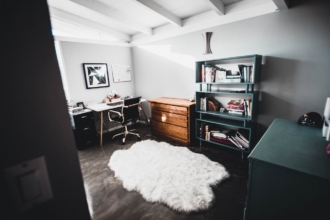With more and more of us working from home these days, it’s essential that we make sure we’re using our time effectively. Whether we work from home on a permanent, regular basis or just once a week, almost all of us need to consider how to be more productive when working from home.
Although the general consensus is that remote workers are more productive than office workers, there are plenty of nuances involved, and productivity depends greatly on the work, the worker, and many other factors. There are lots of tangible productivity gains in working from home — for instance, no commute, no need to dress in a particular way, and no colleagues stopping by your desk for a chat. But anyone who has ever worked from home will know that there are also plenty of challenges to being productive there.
I’ve worked from home on and off for the last 15 years, exclusively for the last three. I also work with remote teams and am obsessed with the subject of productivity. Through my reading, discussions, and personal experiences, I’ve learned a lot about what works and what doesn’t. Here are my most effective and practical tips for being more productive when working from home.
Be flexible — but create a work routine
The great thing about working from home is the flexibility — unfortunately, this is also one of the biggest challenges. Depending on your situation, you can choose your own hours and work whenever you like. For some people, this means that they never get to the work. For others, it results in them always working. Most of us don’t operate too well without the structure of set hours or at least having a rhythm to our days.
Instead of just waking at whatever time and starting work when the inspiration strikes you, decide ahead of time what the pattern of your days will look like. Of course, this could (and should) mean you still take advantage of your flexibility, so design a regular day that suits your particular situation.
For me, my working-from-home routine revolves around being available when my family needs me, making time for daily exercise, and knowing my own body rhythms (I tend to be a night owl and often do my best work late at night). So I do three blocks of work — morning work block, then exercise, afternoon work block, then kids and dinner, and an evening work block.
Your work routine will probably look different than mine, but decide what times you’ll work. This helps you avoid feeling like you’re always working, which helps you be more productive when you are working.
Be deliberate — use an action plan
Now that you know when you’re working, you also need to know exactly what work you’ll do. It’s so easy to sit at the computer and feel like we’re working, but unless we’re very deliberate about what we’re going to do, hours can slip away without us accomplishing anything meaningful.
The best way to be deliberate is to have a daily action plan. This is different from a to-do list as it includes only the things you plan to do that day.
An action plan is easy to create, but it makes a huge difference to your productivity. Each day, reflect on your goals or the big projects you are working on. Then think about what actions you can take today to move them forward. Break big tasks down so they are small — they should each be expected to take less than an hour. Don’t make the mistake of having 20 items on your action list. Do the hard work of prioritizing and choose the three to five most important things. (You can always add more if you get through these, but it’s more important that you get into the habit of actually doing everything on your action list.)
A daily action list with a few small but important items makes a huge difference to your productivity. Put them in the order you intend to do them; then when you start work, don’t let yourself think about what work you feel like doing. Just get started on your first action.
Be transparent — communicate with your team
When you work in an office, there are lots of opportunities to discuss your work and let people know what’s going on. Even just walking past someone’s desk, you can get some understanding of what they’re working on. But when you work from home, you’ve essentially disappeared and often no one has much of an idea what you’re working on.
One of the best ways to avoid this and boost your productivity is to proactively share your work with your team. This practice improves communication and collaboration with your colleagues but also gives you some accountability — one of the most effective productivity tools.
To start sharing your work, simply let someone know what your plan is for the day. Then at the end of the day, let them know what you achieved. There are dedicated team productivity tools that make this easy, or you can use email or your messaging system. If you don’t have a team, you can find a mastermind group or even use your customers to hold you accountable — just tell them you’ll have a piece of work done by the end of the day.
At first, it can feel a bit strange to tell others your plans for the day, but once you try it, you’ll understand why it works so well.
Minimize distractions — plan them as breaks
Depending on your situation, working from home can be fraught with all kinds of possible distractions. Friends and family who know you’re home can drop in or ask you for favors during your work time. There are the noise and demands of family members in the home and endless chores and errands that need to be done. Then, of course, there’s the internet — an infinite shopping mall, entertainment platform, bottomless pit of relevant and irrelevant information, and opportunities to connect with people.
By creating a work routine and using a daily action plan, you can minimize these distractions and ensure you have a good balance between work and home life. For example, I used to get angry at the kids when they returned from school because they would constantly ask me questions, which made it difficult to get anything done. Since then I’ve changed my routine so that I don’t intend to work during these times. Instead, I can do chores and happily chat with the kids at the same time.
If you communicate your work routine to friends and family, they’re much more likely to respect those working times. If it seems like you’re always working, it can be very confusing and people really have no choice but to interrupt you.
As for the chores and errands, if not kept in check, these can easily expand to fill a whole day. When the work gets challenging, these are a great way to procrastinate. Instead of letting these get more time and attention than they deserve, use them as intentional breaks between chunks of real work. For example, only allow yourself to check social media once you’ve done your first action item. Another break could consist of doing 20 minutes of chores around the house. While these are still a kind of work, they’re generally not mentally taxing so use them strategically as an opportunity to give your brain a break.
With a work routine and daily action plan in place, you can vastly increase your personal effectiveness. Add a system of transparency for sharing your work and the habit of planning distractions as intentional breaks, and your working-from-home productivity will skyrocket. Although these ideas seem simple (and they are!), the cumulative impact of doing these things every day is incredible.
Photo by BRUNO CERVERA on Unsplash

















































































Send Comment: